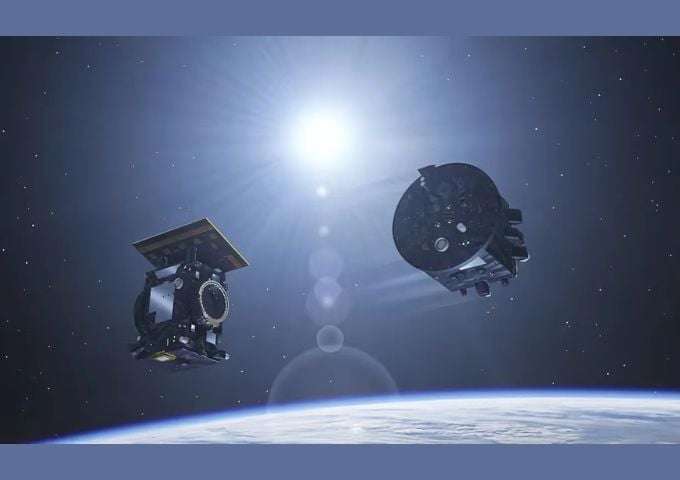Introduction: A New Era in Solar Observation
The European Space Agency (ESA) is on the brink of launching a groundbreaking space mission known as Proba-3, which will use cutting-edge satellite technology to create artificial solar eclipses. This mission aims to advance our understanding of the Sun’s corona by providing continuous, detailed observations. This innovative approach could revolutionize the way scientists study solar phenomena, from solar weather to solar storms.
What is the Proba-3 Mission?
The Proba-3 mission, scheduled to launch from the Satish Dhawan Space Centre in India, marks a significant leap in space exploration. For the first time, two satellites will fly in a precise formation around Earth, maintaining a distance of just one millimeter apart—the thickness of a human fingernail. This formation flying is a significant milestone in space technology, as it will allow the satellites to create artificial solar eclipses on demand.
The mission’s primary goal is to study the Sun’s corona, the outermost part of the Sun’s atmosphere, which has been a subject of fascination and mystery for centuries. By using two satellites to cast a shadow on each other, Proba-3 will allow for detailed, continuous observation of this vital part of the Sun.
How Will the Mission Work?
The Proba-3 mission involves two spacecraft that will travel together in a formation flying configuration. This means that the two satellites will maintain their positions with extreme precision as they orbit Earth. The lead satellite will carry a 1.4-meter-wide disc to block the Sun’s light, casting a controlled shadow on the second satellite, which will be equipped with instruments to study the Sun’s corona.
This shadow will allow the second satellite to observe the corona in unprecedented detail. Unlike traditional solar observations during natural solar eclipses, which are brief and subject to weather interference, Proba-3 will create 50 artificial solar eclipses each year, with each one lasting six hours. This provides scientists with continuous access to study the Sun’s corona, which is not typically visible under normal circumstances.
Key Objectives of the Proba-3 Mission
1. Detailed Study of the Sun’s Corona
The primary objective of the Proba-3 mission is to study the Sun’s corona, a region that is usually hidden by the Sun’s bright surface. The corona is extremely hot, with temperatures exceeding one million degrees Celsius. Scientists have long been puzzled by the corona’s high temperatures and its behavior, which differs from the rest of the Sun. By using the Proba-3 mission to observe the corona in detail, researchers hope to uncover more about these mysteries, including the dynamics of solar weather, solar flares, and coronal mass ejections.
2. Understanding Solar Weather and Solar Storms
Solar weather, including solar flares and coronal mass ejections (CMEs), can have a profound impact on space-based technology and Earth’s atmosphere. These phenomena can disrupt satellites, GPS systems, power grids, and even telecommunications. The Proba-3 mission aims to enhance scientists’ understanding of these solar events, which will help improve predictions of space weather and mitigate the potential impacts on Earth.
3. Advancements in Satellite Technology
In addition to studying the Sun, the Proba-3 mission will also test new technologies related to formation flying, precision alignment, and satellite servicing. The satellites will use optical sensors, LEDs, and precision lasers to ensure that they stay perfectly aligned during their mission. This technology has the potential to transform how satellites are used for scientific research, paving the way for larger and more powerful space-based observatories in the future.
4. Testing Space Debris Removal and Satellite Servicing Techniques
Another important aspect of the Proba-3 mission is its role in testing techniques for servicing satellites and removing space debris. These technologies could be crucial for future space operations, as they may allow for the repair and maintenance of satellites already in orbit. Additionally, these methods could be used to remove debris that poses a threat to active satellites, improving the sustainability of space activities in the long term.
The Technology Behind Formation Flying
The technology behind formation flying is one of the key innovations of the Proba-3 mission. Formation flying involves multiple satellites or spacecraft working together in close proximity, maintaining precise alignment. For the Proba-3 mission, the two satellites will maintain a formation with only one millimeter of separation. This requires advanced technology in optical sensors, lasers, and precision propulsion systems to ensure that the spacecraft can remain in formation during the mission.
To achieve this, the satellites will use a combination of LEDs, optical sensors, and lasers to maintain their position relative to each other. These technologies will allow the spacecraft to adjust their positions as necessary to keep their alignment as they orbit Earth. This approach could pave the way for new types of space-based observatories that rely on multiple satellites working together in formation to create larger instruments for more comprehensive scientific studies.
The Orbital Path of the Proba-3 Satellites
The Proba-3 mission will see the two satellites follow an elliptical orbit around Earth, with a range of 370 miles to 59,546 kilometers from the planet’s surface. The spacecraft will orbit Earth every 19.7 hours, spending six hours each day in formation flying. The satellites will maintain their precise alignment during this time, using their advanced technologies to study the Sun and perform other scientific tasks.
This elliptical orbit is carefully planned to allow for the most efficient and effective observation of the Sun. The spacecraft will be positioned in such a way that the Sun’s light will be blocked, casting a shadow that will enable detailed study of the corona. The mission will run for two years, during which time the satellites will gather invaluable data that will improve our understanding of solar activity and space weather.
Impact of Proba-3 on Future Space Missions
The Proba-3 mission is not just about observing the Sun. It is also about testing new technologies that will shape the future of space exploration. The ability to maintain formation flying with such precision could have significant implications for future space-based observatories and missions. By using multiple satellites working together, future missions could create instruments far larger and more powerful than what a single satellite could achieve.
Moreover, the mission’s success in testing space debris removal and satellite servicing technologies could revolutionize how we manage the growing problem of space debris. By developing techniques to service and maintain satellites in orbit, we could extend the lifespan of space-based assets and reduce the risk posed by debris.
Conclusion: A New Frontier in Solar and Space Research
The Proba-3 mission represents a significant leap forward in both space exploration and solar observation. With its innovative use of formation flying and artificial solar eclipses, the mission will provide scientists with a level of insight into the Sun’s corona that has never been possible before. This will deepen our understanding of solar weather, space storms, and other solar phenomena that have a direct impact on life on Earth.
In addition to its scientific goals, the mission will also advance space technology, opening the door for new types of space missions and research. Whether it’s through the development of larger space observatories or the ability to service satellites in orbit, the Proba-3 mission has the potential to change the way we explore and utilize space.
FAQs
1. What is the primary goal of the Proba-3 mission?
The primary goal of the Proba-3 mission is to study the Sun’s corona in unprecedented detail by creating artificial solar eclipses using two satellites flying in precise formation.
2. How will the Proba-3 satellites stay in formation?
The satellites will use optical sensors, LEDs, and precision lasers to maintain their position within one millimeter of separation during the mission.
3. What will the Proba-3 mission teach us about the Sun?
The mission aims to provide insights into the Sun’s corona, including its high temperatures, solar weather, and phenomena like solar flares and coronal mass ejections, which affect space technology and Earth.
4. How long will the Proba-3 mission last?
The Proba-3 mission is planned to last for two years, with the satellites orbiting Earth every 19.7 hours.
5. What other technologies will the Proba-3 mission test?
In addition to studying the Sun, the Proba-3 mission will test techniques for satellite servicing and space debris removal, which could benefit future space operations.
SEE ALSO:



